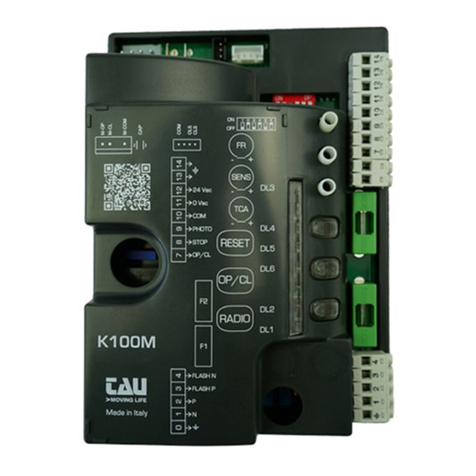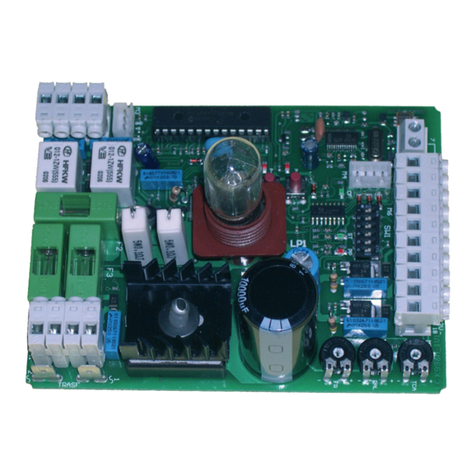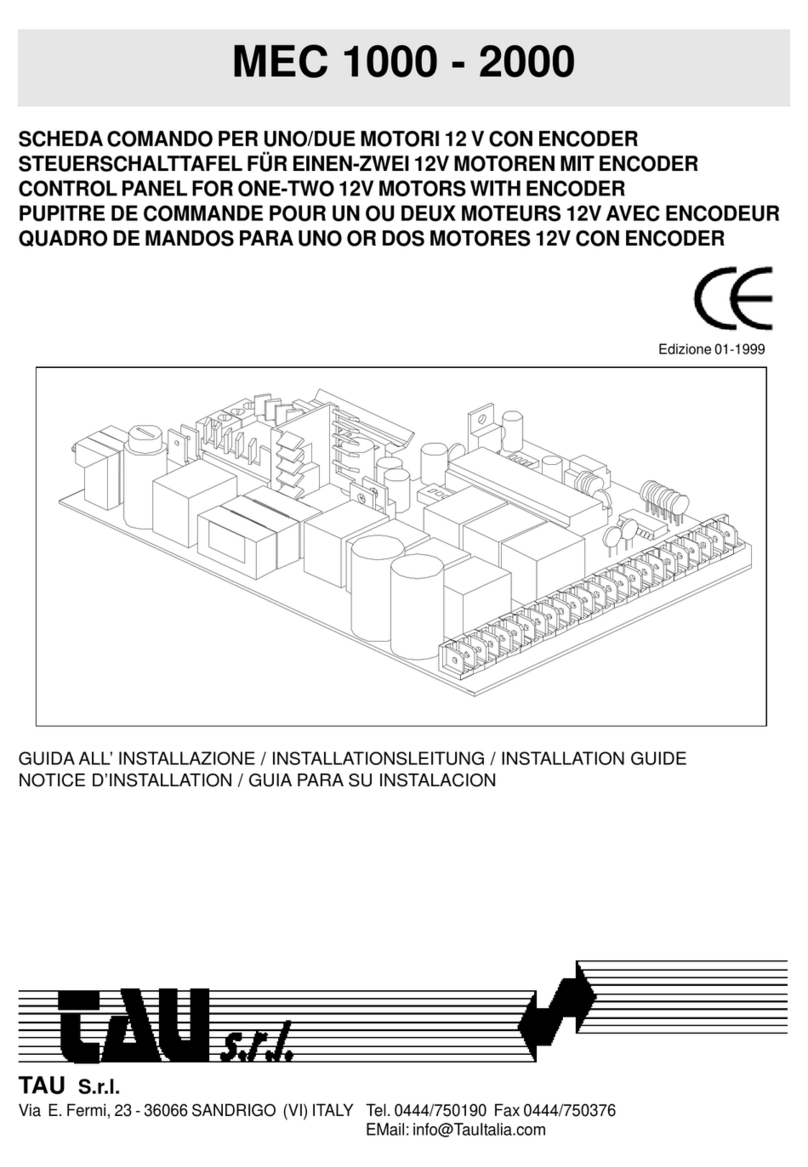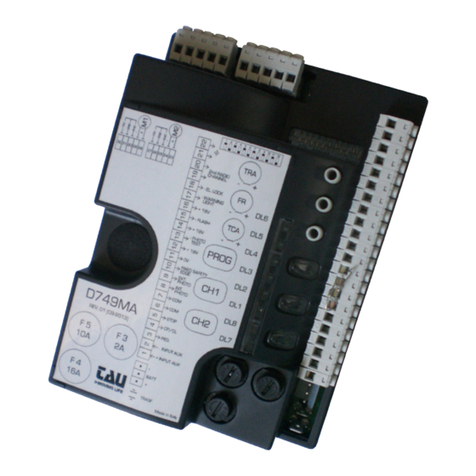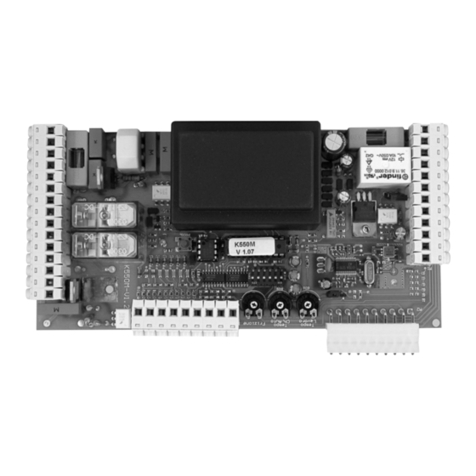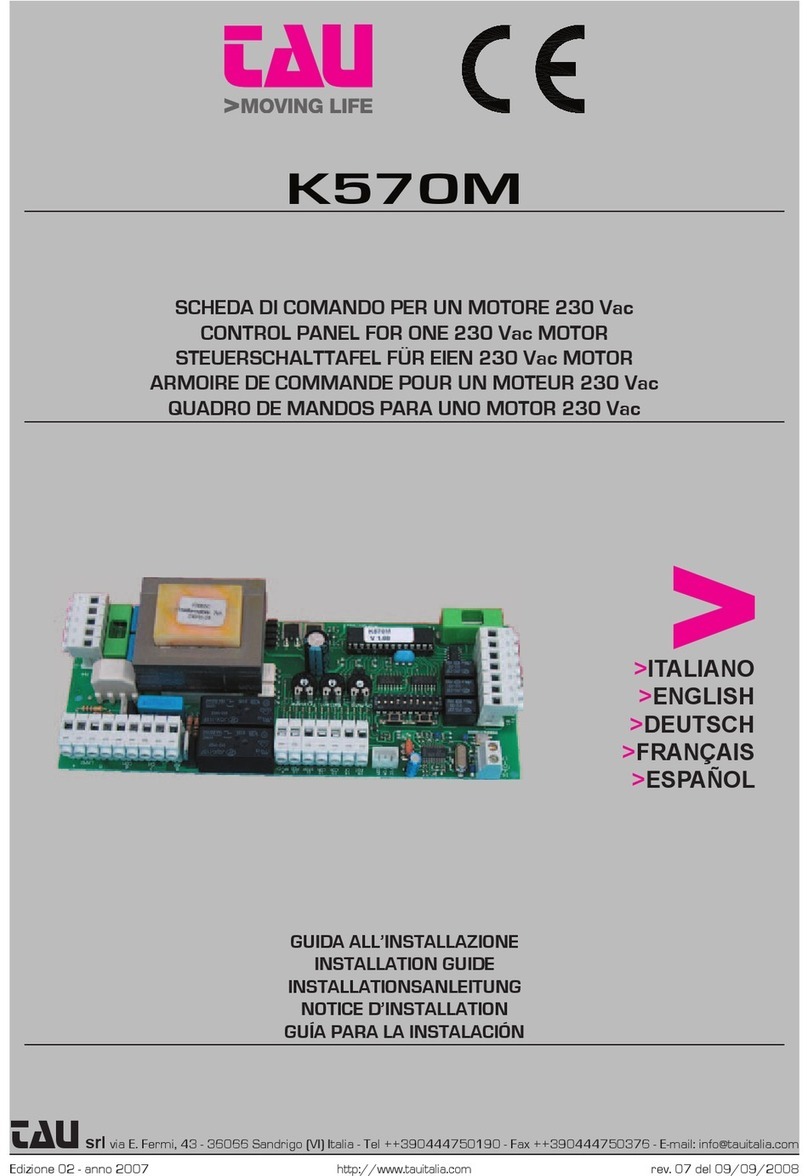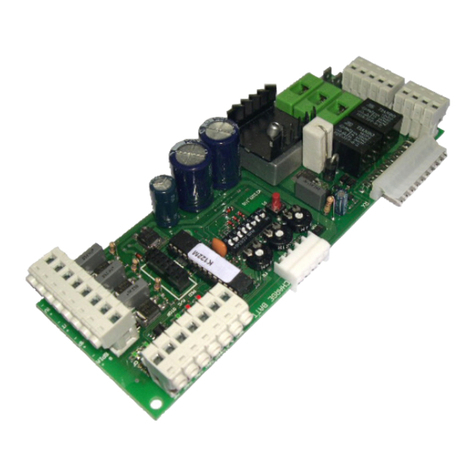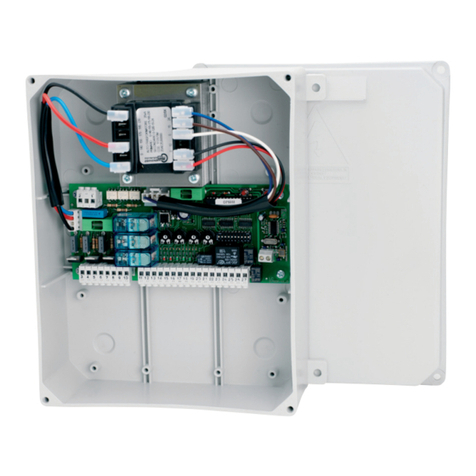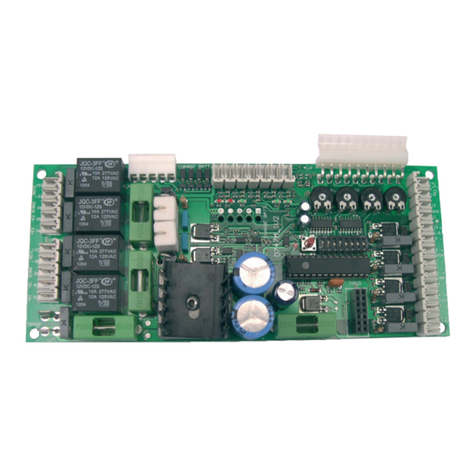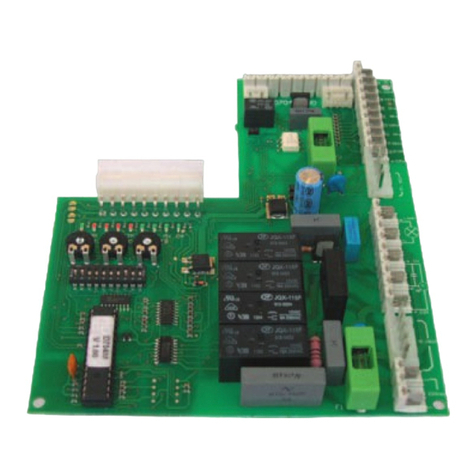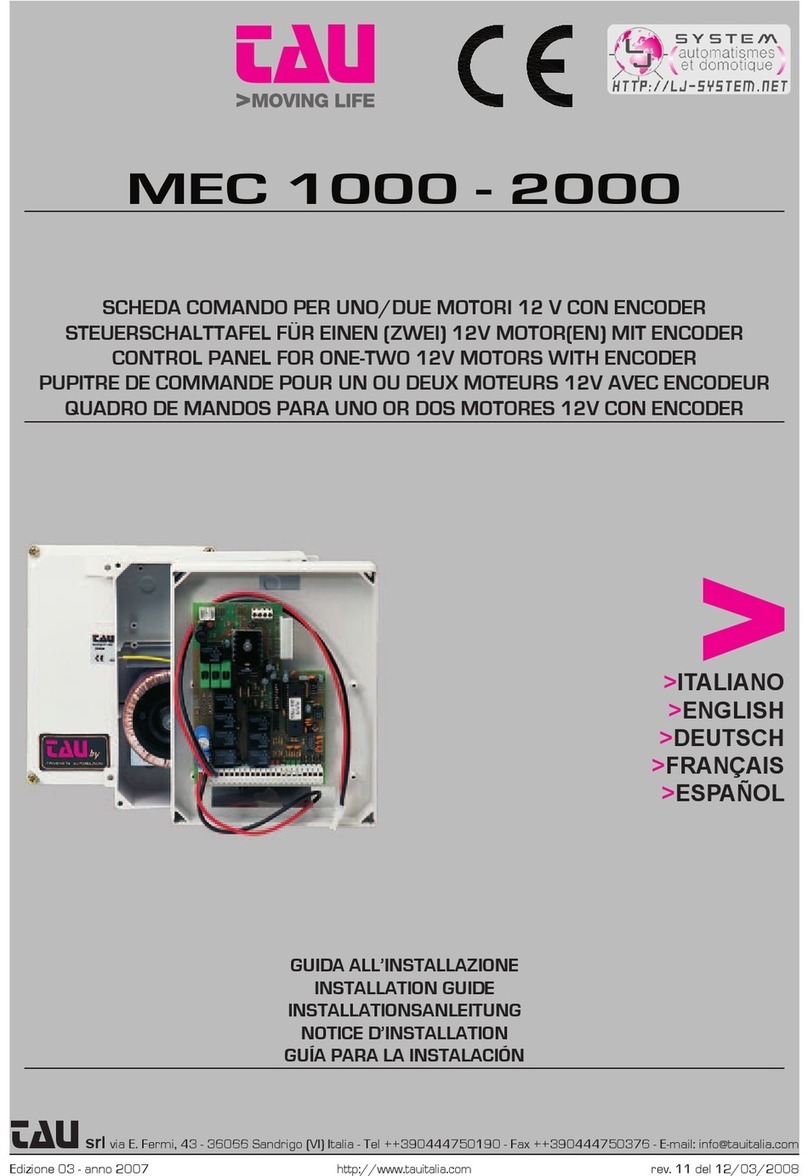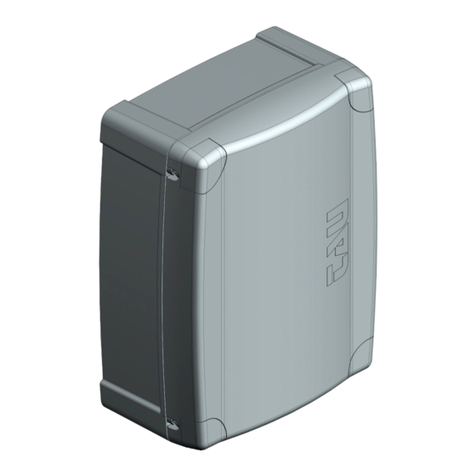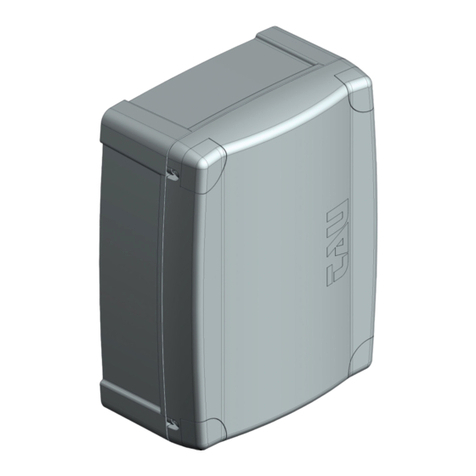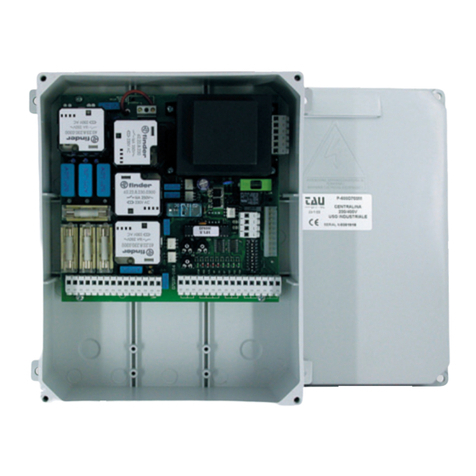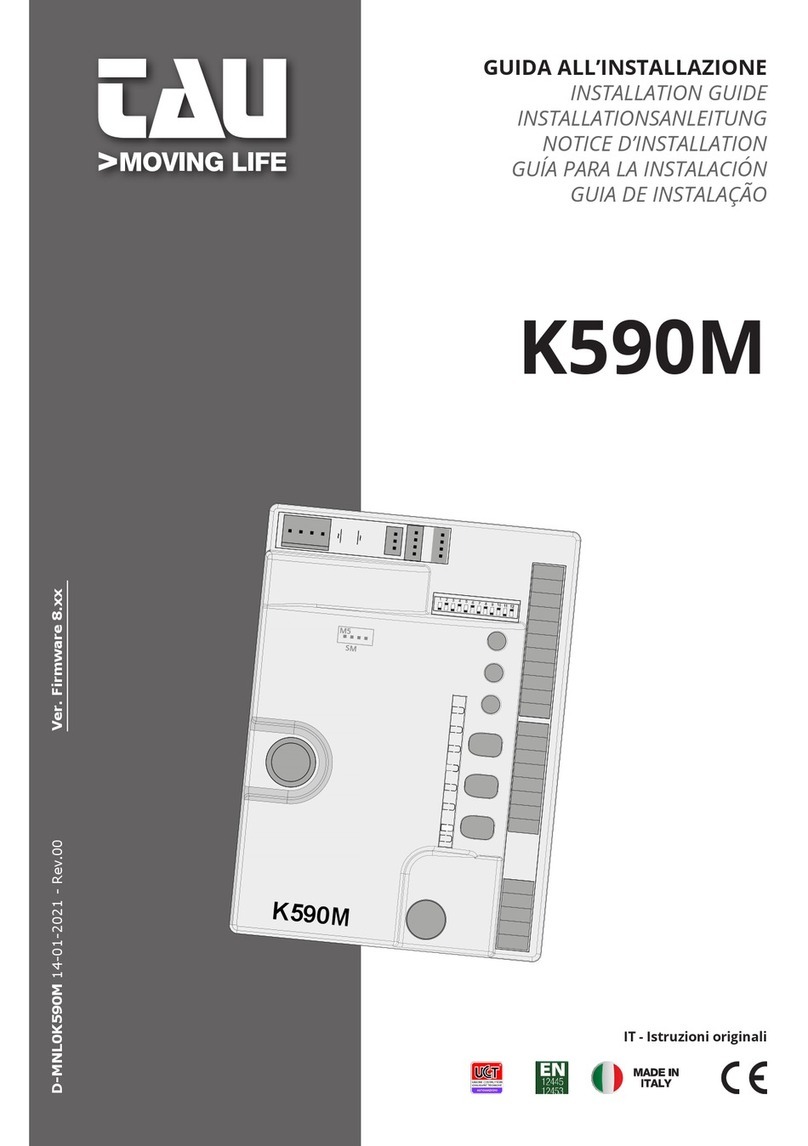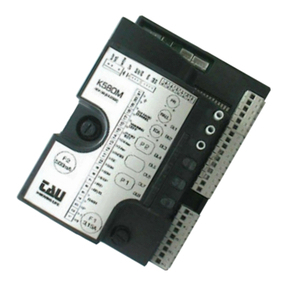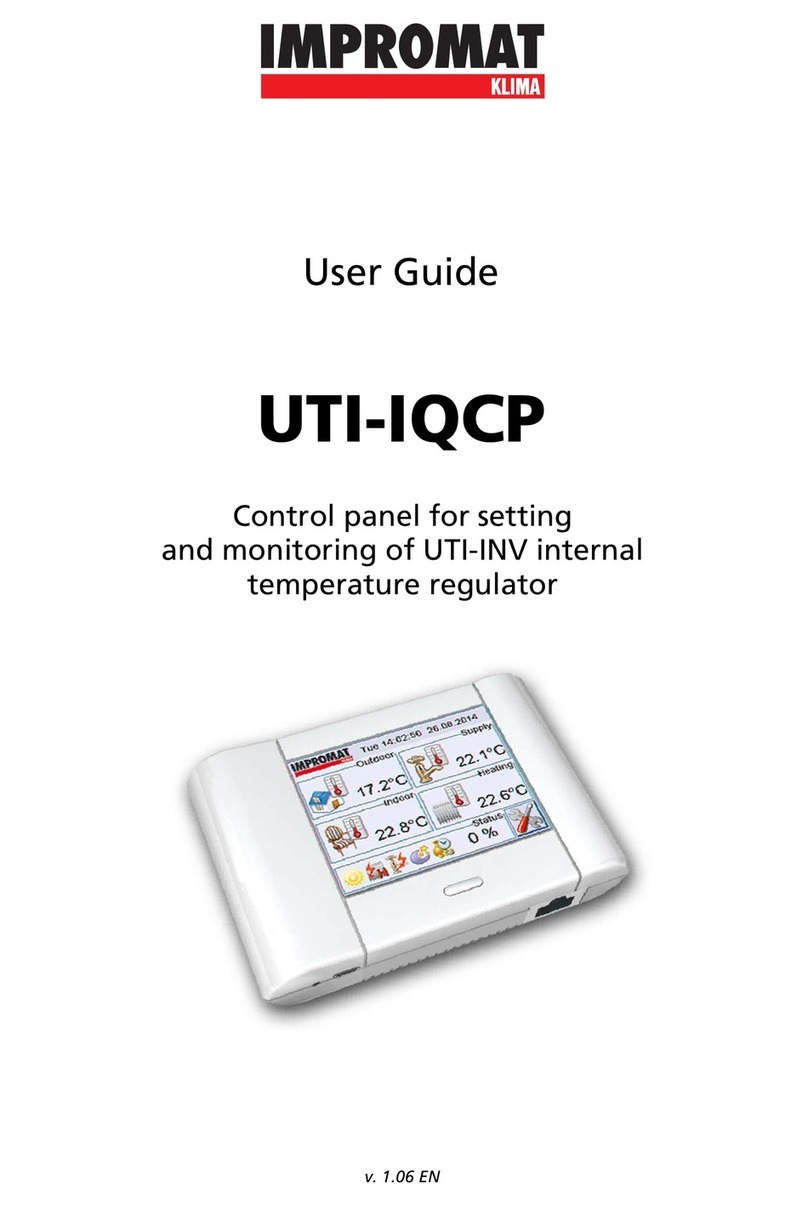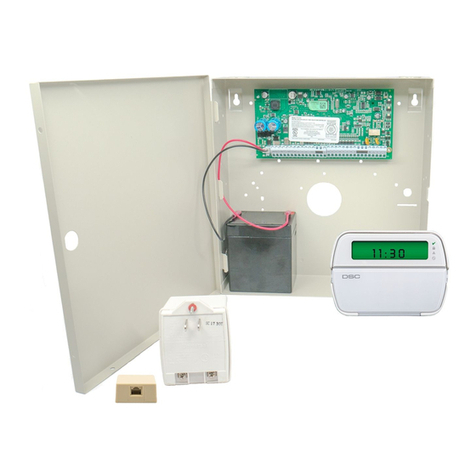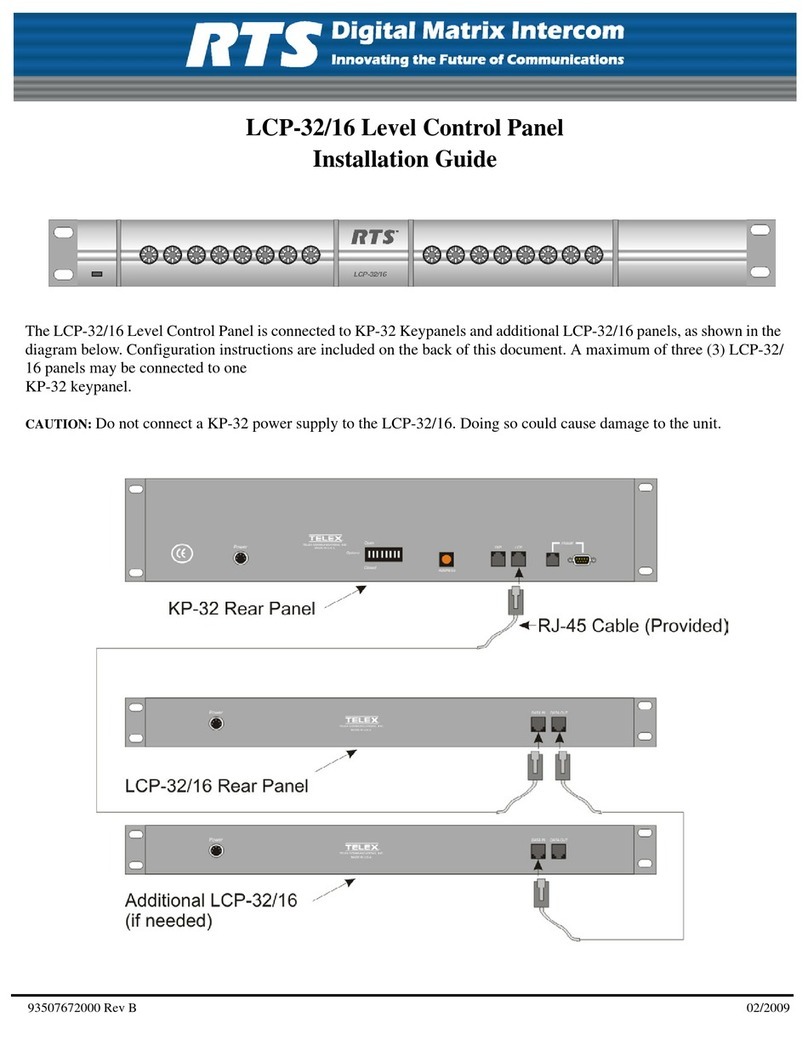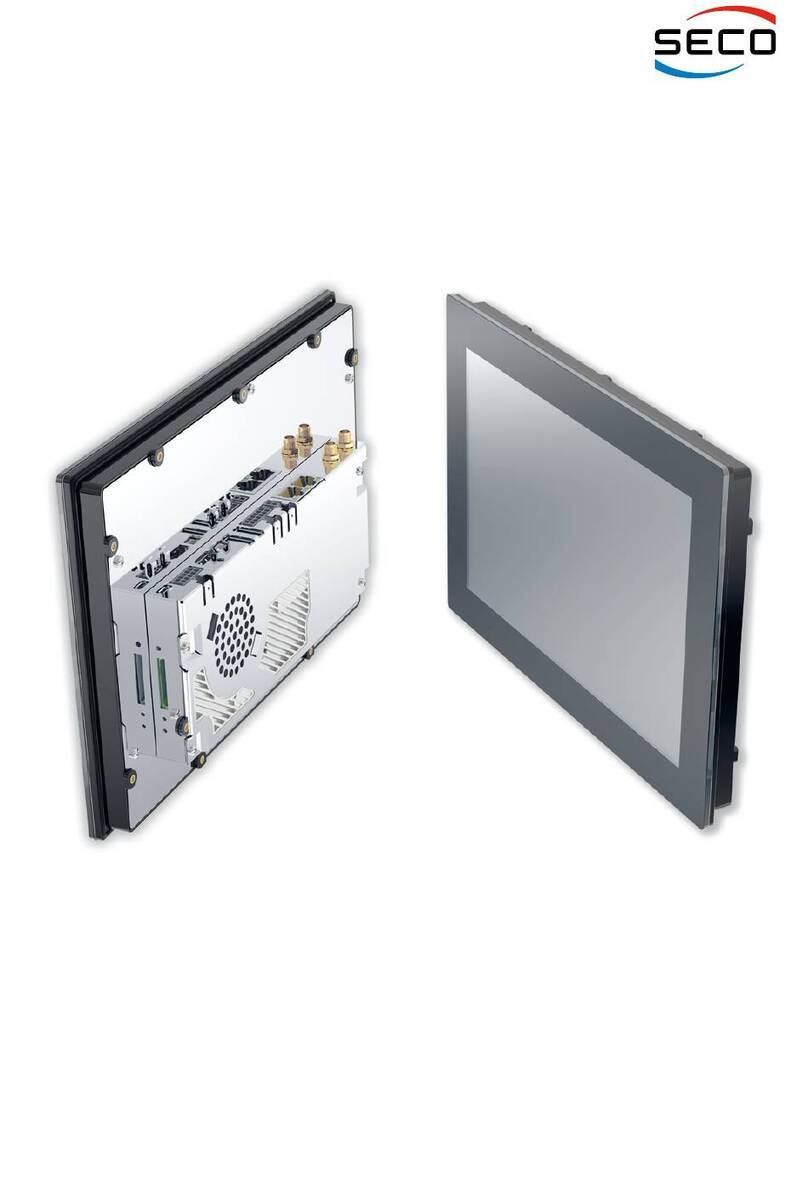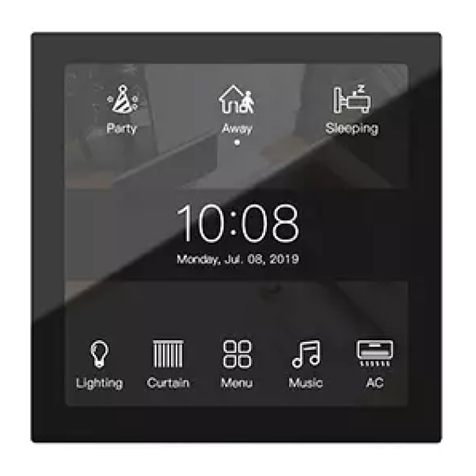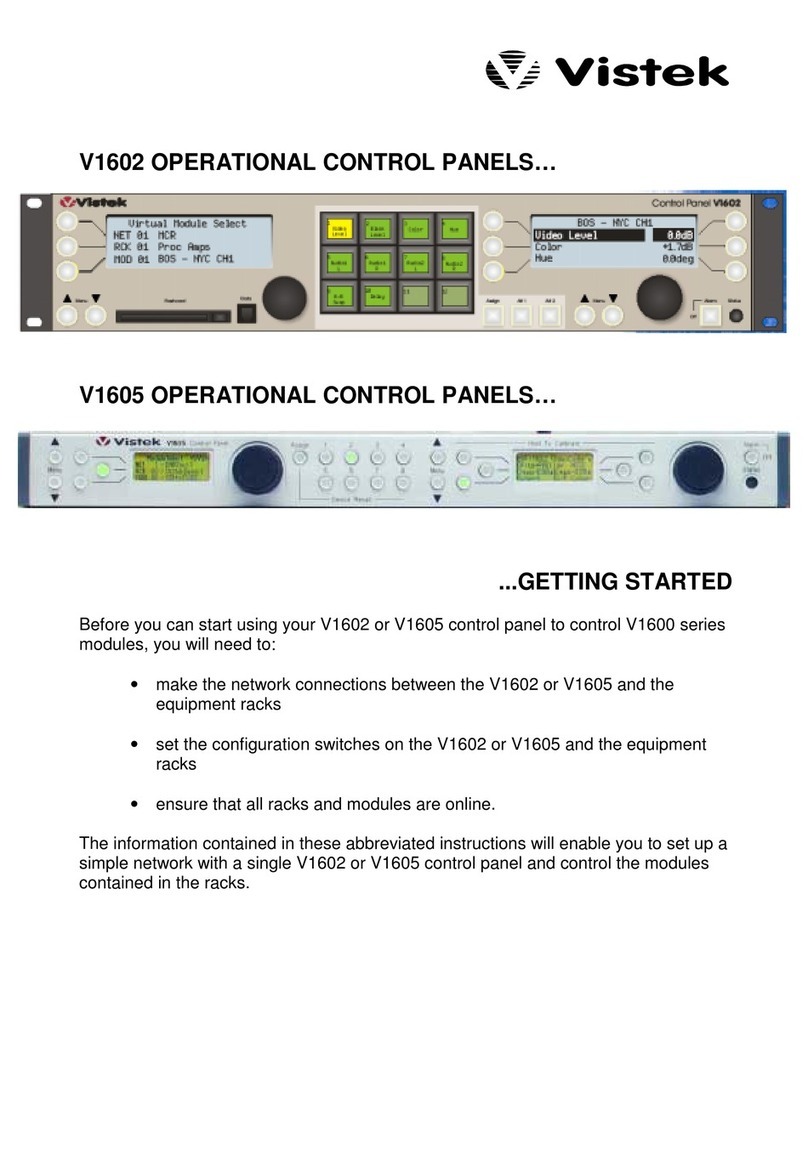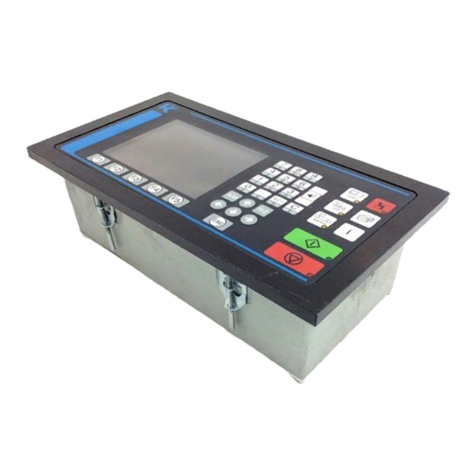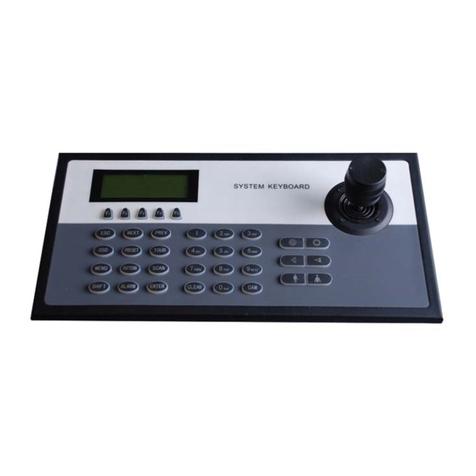tau K101M Setup guide

Introduzione
Attenzione: questo prodotto può essere installato solo da installatori professionisti. Solamente elettricisti qualicati e addestrati possono
effettuare i collegamenti, le programmazioni e la manutenzione di controllo.
Nessuna informazione contenuta nel presente fascicolo può essere considerata d’interesse per l’utilizzatore nale. Questo manuale è allegato alla cen-
tralina K101M, non deve pertanto essere utilizzato per prodotti diversi!
Avvertenze importanti:
Togliere l’alimentazione di rete alla scheda prima di accedervi.
La centralina K101M è destinata al comando di un motoriduttore elettromeccanico per l’automazione di cancelli, porte e portoni.
Ogni altro uso è improprio e, quindi, vietato dalle normative vigenti.
Si consiglia di leggere attentamente tutte le istruzioni prima di procedere con l’installazione.
INSTALLAZIONE
Prima di procedere assicurarsi del buon funzionamento della parte meccanica. Vericare inoltre che il gruppo motoriduttore sia stato installato
correttamente seguendo le relative istruzioni.
NB : si ricorda l’obbligo di mettere a massa l’impianto nonché di rispettare le normative sulla sicurezza in vigore in ciascun paese.
ATTENZIONE:
- non utilizzare cavi unilari (a conduttore unico), es. quelli citofonici, al ne di evitare interruzioni sulla linea e falsi contatti;
- non riutilizzare vecchi cavi preesistenti.
LA NON OSSERVANZA DELLE SOPRAELENCATE ISTRUZIONI PUÒ PREGIUDICARE IL BUON FUNZIONAMENTO DELL’APPARECCHIATURA E
CREARE PERICOLO PER LE PERSONE, PERTANTO LA “CASA COSTRUTTRICE” DECLINA OGNI RESPONSABILITÀ PER EVENTUALI MAL FUN-
ZIONAMENTI E DANNI DOVUTI ALLA LORO INOSSERVANZA.
SCHEDA DI COMANDO PER BARRIERA 230 V AC
• LOGICA CON MICROPROCESSORE
• STATO DEGLI INGRESSI VISUALIZZATO DA LEDs
• PROTEZIONE INGRESSO LINEA CON FUSIBILE
• CIRCUITO DI LAMPEGGIO INCORPORATO
• RADIO RICEVITORE 433,92 MHz INTEGRATO
• TEMPO DI LAVORO FISSO (max. 40 sec.)
• RILEVAMENTO AUTOMATICO DELLA FREQUENZA DI ALIMENTAZIONE (50 o 60 Hz)
COLLAUDO
A collegamento ultimato:
• I Leds verdi devono essere tutti accesi (corrispondono ciascuno ad un ingresso Normalmente Chiuso). Si spengono solo quando sono interessati i
comandi ai quali sono associati.
• I Leds rossi dei comandi di apertura devono essere tutti spenti (corrispondono ciascuno ad un ingresso Normalmente Aperto) si accendono solo quando
sono interessati i comandi ai quali sono associati; il Led rosso DL1 deve essere acceso sso.
CARATTERISTICHE TECNICHE
Alimentazione scheda 230 V AC - 50-60 Hz
Potenza nominale 400 W
Fusibile rapido protezione alimentazione ingresso 230 V AC (F1 - 5x20) F 3,15 A
Tensione circuiti alimentazione motore 230 V AC
Tensione alimentazione circuiti dispositivi ausiliari 24 V AC
Fusibile rapido protezione ausiliari 24 V AC (F2 - 5x20) F 200 mA
Temperatura di funzionamento -20 °C ÷ +55 °C
Grado di protezione del contenitore IP 44
LED DI DIAGNOSI
DL1 (RADIO CONTROLS) / ROSSO led di segnalazione ERRORI e programmazione RADIOCOMANDI
DL2 (OPEN/CLOSE) / ROSSO led di segnalazione pulsante APRE/CHIUDE
DL3 (PHOTO) / VERDE led di segnalazione FOTOCELLULA
DL4 (CLOSE LIMIT SWITCH) / VERDE led di segnalazione FINECORSA IN CHIUSURA
DL5 (OPEN LIMIT SWITCH) / VERDE led di segnalazione FINECORSA IN APERTURA
DL6 (STOP) / VERDE led di segnalazione pulsante STOP
Italiano
GUIDA ALL’INSTALLAZIONE
K101M
Quadro di comando per barriera automatica RBLO-E
D_MNL0K101M 27-11-2013 - Rev.01
FR
SENS
TCA
F2
F1
7
8
9
10
11
12
13
14
1
2
3
Neutral
230 V AC
Power supply
Phase
M-OP
CLS
OLS
COM
FS1
FS2
M-COM
M-CL
4
RADIO
OP/CL
DL3
DL4
DL5
DL6
DL2
DL1
1234
1234
Flashing
light
230 V AC
max. 50W
Open/Close
Stop
Antenna
K101M
Dip-switches
ON
M2
M3
DL3
DL4
DL5
DL6
DL2
DL1
PHOTO
CLOSE LIMIT SWITCH
OPEN LIMIT SWITCH
STOP
OPEN/CLOSE
RADIO CONTROLS
TCA
+-
SENS
+-
FR
+-
Photocells
Common
Photocell
RX
12345
TX
1 2
0 V AC
Photocell - 24 V AC
IT - Istruzioni originali

COLLEGAMENTI ALLA MORSETTIERA
Morsetti Funzione Descrizione
1 - 2 ALIMENTAZIONE ingresso ALIMENTAZIONE 230/115 V AC 50÷60Hz. 1= NEUTRO, 2= FASE;
3 - 4 LAMPEGGIANTE uscita LAMPEGGIANTE 230/115 VAC 50 W max. Il segnale fornito è già opportunamente modulato per l’uso diretto. La
frequenza di lampeggio è doppia in fase di chiusura; 3= 230 V AC, 4= 0 V AC;
7 - 10 APRE/CHIUDE ingresso pulsante APRE/CHIUDE (contatto Normalmente Aperto);
8 - 10 STOP ingresso pulsante STOP (contatto Normalmente Chiuso);
9 - 10 FOTOCELLULE
ingresso FOTOCELLULE O DISPOSITIVI DI SICUREZZA attivi in chiusura (contatto Normalmente Chiuso); il loro inter-
vento, in fase di chiusura provoca l’arresto seguito dalla totale riapertura dell’automazione, (10= Comune). Nel caso di più
dispositivi di sicurezza, collegare tutti i contatti NC IN SERIE.
11 - 12 FOTOCELLULE
24V AC
uscita 24 V AC 20 W per l’ALIMENTAZIONE DELLE FOTOCELLULE, RICEVITORI ESTERNI, etc; collegare max. n° 3
coppie di fotocellule. 11= 0 V AC, 12= 24 V AC;
13 - 14 ANTENNA Ingresso antenna per RX 433,92 MHz incorporata; 13= MASSA, 14= SEGNALE;
M2 FINE CORSA innesto rapido per connessione FINE CORSA (contatti Normalmente Chiusi). Arancio= FineCorsaChiusura (CLS), rosso=
FineCorsaApertura (OLS), grigio= Comune (COM);
FS1 - FS2 CONDESATORE faston per connessione CONDENSATORE di spunto del motore;
M3 MOTORE innesto rapido per connessione MOTORE monofase 230 V AC comune= BLU (M-COM); fase chiusura= MARRONE (M-
CL); fase apertura= NERO (M-OP).
REGOLAZIONI LOGICHE
TRIMMER
FR.
Regolazione coppia motore. Regolare il trimmer per una spinta dell’automazione atta a garantire il funzionamento, facendo attenzione a
non superare quella consentita dalle norme in uso (EN 12453). Ruotando il trimmer in senso orario (+) si aumenta la coppia motore,
viceversa, ruotandolo in senso antiorario (-), diminuisce.
SENS.
regolazione soglia rilevamento necorsa. Ruotando il trimmer in senso orario (+) si aumenta la soglia di rilevamento (il motore si
ferma prima), viceversa, ruotandolo in senso antiorario (-), diminuisce (il motore si ferma dopo).
Nota: il trimmer non regola la sensibilità agli ostacoli, ma la sensibilità al rilevamento della battuta meccanica di ne corsa (in ogni
caso, dopo 40 sec. il motore si ferma). È pertanto necessario regolarlo correttamente, per evitare surriscaldamenti del motore.
T.C.A. Regolazione tempo di richiusura automatica da 1 a 120 secondi.
Dip switch
1CHIUSURA
AUTOMATICA
On ad apertura completata, la chiusura dell’automazione è automatica trascorso un tempo impostato sul trimmer T.C.A.;
Off la chiusura necessita di un comando manuale;
22 / 4 TEMPI
On ad automazione funzionante, una sequenza di comandi di apertura/chiusura induce il cancello ad una APERTURA-
CHIUSURA-APERTURA-CHIUSURA, etc.;
Off nelle stesse condizioni, la stessa sequenza di comandi di apertura/chiusura induce il cancello ad una APERTURA-STOP-
CHIUSURA-STOP-APERTURA-STOP, etc. (funzione passo-passo);
3NO REVERSE On l’automazione ignora i comandi di chiusura durante l’apertura.
Off l’automazione si comporta come stabilito dal dip switch nr. 2.
4DIREZIONE
APERTURA
On funzionamento per anta con apertura verso sinistra;
Off funzionamento per anta con apertura verso destra;
PROCEDURA DI IMPOSTAZIONE DELLA CORSA
Non è necessario eseguire alcuna procedura di impostazione della corsa, la centrale inizia a funzionare appena collegata ed alimentata.
CARATTERISTICHE DELLA K101M
LED - DL1
Il led, oltre ad indicare la programmazione dei radiocomandi, segnala eventuali errori con una serie di lampeggi predeniti:
sempre acceso: funzionamento regolare;
Lampeggio breve: mancato rilevamento automatico della frequenza di rete;
Contattare l’assistenza tecnica;
8 lampeggi: assenza segnale motore;
Controllare cablaggio, vericare che il motore giri liberamente;
L’indicazione di più errori viene eseguita con una pausa di 2 sec. tra una segnalazione e l’altra. L’indicazione degli errori persiste no all’esecuzione di una
manovra completa (apertura e chiusura) dell’automazione.
FUNZIONI AVANZATE
Funzione orologio: è possibile utilizzare un timer (esempio settimanale) collegato all’ingresso del pulsante apre-chiude per mantenere aperta l’automa-
zione in determinate fascie orarie e permetterne poi la richiusura automatica.
N.B. I’automazione rimane aperta nchè l’ingresso Ap/Ch rimane impegnato.
RADIO RICEVITORE 433,92 MHz INTEGRATO
Il radio ricevitore può apprendere no ad un max di 30 codici rolling code (BUG2R, BUG4R, K-SLIM-RP, T-4RP) da impostare liberamente.
Il canale radio comanda direttamente la scheda di comando per l’apertura dell’automazione.
APPRENDIMENTO RADIOCOMANDI
RADIO = Canale radio
OP/CL = APRE/CHIUDE
1_ premere brevemente il tasto RADIO se si desidera associare un radiocomando alla funzione APRE/CHIUDE;
2_ il led DL1 si spegne per indicare la modalità di apprendimento dei codici (se non viene immesso nessun codice entro 10 secondi, la scheda esce dalla
modalità di programmazione);
3_ premere il tasto del radiocomando che si desidera utilizzare;
4_ il led DL1 si riaccende per segnalare l’avvenuta memorizzazione (se ciò non accade, attendere 10 secondi e riprendere dal punto 1);
5_ se si desidera memorizzare altri radiocomandi, ripetere la procedura dal punto 1 no ad un massimo di 30 trasmettitori;
6_ se si desidera uscire dalla modalità di apprendimento senza memorizzare un codice, premere brvemente il tasto RADIO.
N.B.: nel caso di raggiungimento del nr massimo di radiocomandi (nr 30), il led DL1 inizierà a lampeggiare velocemente per circa 3 secondi
senza però eseguire la memorizzazione.
PROGRAMMAZIONE REMOTA TRAMITE T-4RP e K-SLIM-RP
È possibile eseguire l’apprendimento remoto della nuova versione (V 4.X) di radiocomandi T-4RP e K-SLIM-RP, ossia senza agire direttamente sul tasti
di programmazione della ricevente.
Sarà sufciente disporre di un radiocomando già programmato nella ricevente per poter aprire la procedura di programmazione remota dei nuovi radioco-
mandi, programmati tramite TAUPROG. Seguire la procedura riportata sulle istruzioni del radiocomando T-4RP e K-SLIM-RP.
CANCELLAZIONE RADIOCOMANDI
1_ tenere premuto per 3 secondi ca. il tasto RADIO al ne di cancellare tutti i radiocomandi ad esso associati;
2_ il led DL1 inizia a lampeggiare lentamente per indicare che la modalità di cancellazione è attivata;
3_ tenere premuto nuovamente il tasto RADIO per 3 secondi;
4_ il led DL1 si spegne per 3 secondi ca. per poi riaccendersi sso ad indicare l’avvenuta cancellazione;
5_ se si desidera uscire dalla modalità di cancellazione senza memorizzare un codice, premere brevemente il tasto RADIO.
MALFUNZIONAMENTI: POSSIBILI CAUSE E RIMEDI
L’automazione non parte
a_ Vericare con lo strumento (Multimetro) la presenza dell’alimentazione 230V AC;
b_ Vericare che i contatti N.C. della scheda siano effettivamente normalmente chiusi (4 led verdi accesi) e che i led rossi dei comandi di apertura
siano spenti;
c_ Vericare che il led rosso DL1 sia acceso sso;
d_ Controllare con lo strumento (Multimetro) che i fusibili siano integri.
Il radiocomando ha poca portata
a_ Controllare che il collegamento della massa e del segnale dell’antenna non sia invertito;
b_ Non eseguire giunzioni per allungare il cavo dell’antenna;
c_ Non installare l’antenna in posizioni basse o in posizioni nascoste dalla muratura o dal pilastro;
d_ Controllare lo stato delle pile del radiocomando.
Il cancello si apre al contrario
a_ Invertire la posizione del di\p-switch nr. 4, dopo aver tolto l’alimentazione al quadro di comando.
DICHIARAZIONE DI INCORPORAZIONE DEL COSTRUTTORE
(ai sensi della Direttiva Europea 2006/42/CE AlI. II.B)
Fabbricante: TAU S.r.l.
Indirizzo: Via E. Fermi, 43
36066 Sandrigo (Vi)
ITALIA
Dichiara sotto la propria responsabilità che il prodotto: Centrale di comando
realizzato per il movimento automatico di: Barriere stradali
per uso in ambiente: Generico
completo di: Radioricevente
Modello: K101M
Tipo: K101M
Numero di serie: vedi etichetta argentata
Denominazione commerciale: Quadro di comando per barriere automatiche
È realizzato per essere incorporato su una chiusura (barriera automatica) o per essere assemblato con altri dispositivi al ne di movimentare una tale chiusura per
costituire una macchine ai sensi della Direttiva Macchine 2006/42/CE.
Dichiara inoltre che questo prodotto è conforme ai requisiti essenziali di sicurezza delle seguenti ulteriori direttive CEE:
- 2006/95/CE Direttiva Bassa Tensione
- 2004/108/CE Direttiva Compatibilità Elettromagnetica
ed, ove richiesto, alla Direttiva:
- 1999/5/CE Apparecchiature Radio e apparecchiature terminali di telecomunicazione
Dichiara inoltre che non è consentito mettere in servizio il macchinario no a che la macchina in cui sarà incorporato o di cui diverrà componente sia stata
identicata e ne sia stata dichiarata la conformità alle condizioni della Direttiva 2006/42/CE.
Si impegna a trasmettere, su richiesta adeguatamente motivata delle autorità nazionali, informazioni pertinenti sulle quasi-macchine.
Sandrigo, 04/07/2013
Il Rappresentante Legale
_________________________________________
Bruno Danieli
Nome e indirizzo della persona autorizzata a costituire la documentazione tecnica pertinente:
Loris Virgilio Danieli - via E. Fermi, 43 - 36066 Sandrigo (Vi) Italia

INSTALLATION GUIDE
K101M
Control panel for RBLO-E automatic barrier
WARNING!
Attention: This product may only be installed from professional installers. Only qualied and trained electricians may connect, programme and
service the controls.
No information given in this manual can be considered as being of interest to end users.
This manual is enclosed with control unit K101M and may therefore not be used for different products!
Important information:
Disconnect electric power to the system before making maintenance, repairs or removing covers
The K101M control unit has been designed to control a electromechanical sliding door operator.
Any other use is considered improper and is consequently forbidden by current laws.
Read all instructions carefully and completely before attempting to install and use this automatic gate operator!
INSTALLATION
Make sure the gate has been properly installed and slides freely in both directions. Repair or replace all worn or damaged gate hardware prior
to installation. A freely moving gate will require less force to operate and will enhance the performance of the operator and safety devices used
with the system.
Also check that the gate operator assembly has been installed according to the instructions.
WARNING: The automatic gate operator must be grounded - All Federal, State and local safety codes must be observed.
ATTENTION:
- do not use solid wire, use only multi threaded wire
- do not reuse pre-existing electric wire.
IF THE ABOVE INSTRUCTIONS ARE NOT FOLLOWED THE “MANUFACTURER” SHALL IN NO EVENT BE LIABLE FOR DIRECT, INDIRECT, INCI-
DENTAL, SPECIAL OR CONSEQUENTIAL DAMAGES OR LOSS OF PROFITS WHETHER BASED IN CONTRACT TORT OR ANY OTHER LEGAL
THEORY DURING THE COURSE OF THE WARRANTY OR AT ANY TIME THEREAFTER.
CONTROL PANEL FOR 230 V AC BARRIER
MICROPROCESSOR-CONTROLLED LOGIC
STATUS LEDS
LINE FUSE
BUILT-IN FLASHING LIGHT CIRCUIT
BUILT-IN 433.92 MHz RADIO RECEIVER
MAX. OPERATING TIME 40”
AUTOMATIC 50 / 60 HZ FREQUENCY DETECTION
TESTING
Once the connection has been completed:
• All the green LEDs must be ON (each of them corresponds to a Normally Closed input). They will turn OFF when the controls to which they are as-
sociated are operated.
• The red opening command LEDs must be OFF (each corresponding to a Normally Open input). They will turn ON when the commands they are as-
sociated with are given; red LED DL1 must be ON steadily.
TECHNICAL CHARACTERISTICS
Power input – control board 230 V AC - 50-60 Hz
Nominal power 400 W
230 V AC Input protection fast blow fuse (F1 - 5x20) F 3,15 A
Power input – motors 230 V AC
Power input – auxiliary circuits 24 V AC
24 V AC Input (auxiliary circuits) fast blow fuse (F2 - 5x20) F 500 mA
Working temperature -20°C ÷ +55°C
Protection degree IP 44
DIAGNOSTICS LED
DL1 (RADIO CONTROLS) / RED ERROR message / PROGRAMMING of transmitters
DL2 (OPEN/CLOSE) / RED OPEN / CLOSE pushbutton activated
DL3 (PHOTO) / GREEN PHOTOCELL activated
DL4 (CLOSE LIMIT SWITCH) / GREEN CLOSING LIMIT SWITCH activated
DL5 (OPEN LIMIT SWITCH) / GREEN OPENING LIMIT SWITCH activated
DL6 (STOP) / GREEN STOP pushbutton activated
English
FR
SENS
TCA
F2
F1
7
8
9
10
11
12
13
14
1
2
3
Neutral
230 V AC
Power supply
Phase
M-OP
CLS
OLS
COM
FS1
FS2
M-COM
M-CL
4
RADIO
OP/CL
DL3
DL4
DL5
DL6
DL2
DL1
1234
1234
Flashing
light
230 V AC
max. 50W
Open/Close
Stop
Antenna
K101M
Dip-switches
ON
M2
M3
DL3
DL4
DL5
DL6
DL2
DL1
PHOTO
CLOSE LIMIT SWITCH
OPEN LIMIT SWITCH
STOP
OPEN/CLOSE
RADIO CONTROLS
TCA
+-
SENS
+-
FR
+-
Photocells
Common
Photocell
RX
12345
TX
1 2
0 V AC
Photocell - 24 V AC
GB - Translation of original instructions
D_MNL0K101M 27-11-2013 - Rev.01

TERMINAL BOARD CONNECTIONS
Terminals Function Description
1 + 2 POWER SUPPLY POWER input 230/115 V AC 50-60 Hz. 1= NEUTRAL 2= PHASE;
3 + 4 FLASHING LIGHT FLASHING LIGHT output 230/115 V AC, max. 50 W. The signal is already modulated for direct use; fast ashing during
closing, slow during opening. 3= 230/115 V AC, 4= 0 V AC;
7 + 10 OPEN/CLOSE OPEN/CLOSE input (Normally Open contact);
8 + 10 STOP STOP input (Normally Closed contact);
9 + 10 PHOTOCELLS
PHOTOCELLS OR SAFETY DEVICES input; active during closure (Normally Closed contact); the automation will stop
during closing and totally reopen it, (10= Common). If there is more than one safety device, connect all the NC contacts
IN SERIES.
11 + 12 24V AC
PHOTOCELLS 24 V AC 10 W output to Photocells, Receivers etc.; connect a up to 3 pair of photocells. 11= 0 V AC, 12= 24 V AC;
13 + 14 AERIAL 433,92 MHz built-in RX aerial input; 13= EARTH, 14= SIGNAL;
M2 LIMIT SWITCH Quick coupling for LIMIT SWITCH connection (Normally Closed contacts).
ORANGE= Closing Limit Switch (CLS), RED= Opening LimitSwitch (OLS), GREY= Common (COM);
FS1 + FS2 CAPACITOR CAPACITOR Terminals for motor start-up;
M3 MOTOR Quick coupling for 230 V AC single-phase MOTOR connection. BLUE= common (M-COM);
BROWN= closing (M-CL); BLACK= opening (M-OP).
LOGIC ADJUSTMENTS
TRIMMER
FR.
Motor torque adjustment. Turning the trimmer clockwise (+) the torque will be increased; Turning the trimmer counterclockwise (-) the
torque will be decreased.
Note: The trimmer is set to provide sufcient thrust to work the automation within the limits established by current standards
(EN 12453).
SENS.
Limit Switch Threshold. Turning the trimmer clockwise (+) the detection threshold will be increased (the motor will stops earlier); Turning
the trimmer counter-clockwise (-) the detection threshold will be decreased (the motor stops later).
Warning: the trimmer won’t adjust the sensitivity to obstacles, only the sensitivity towards the mechanical stopper (in any case,
motor will stop after 40”). It is therefore necessary to adjust correctly the parameter in order to avoid motor overheating.
T.C.A.
Automatic closing time adjustment. Turning the trimmer clockwise (+) time will be increased; Turning the trimmer counterclockwise (-) the
time will be decreased.
Note: The time values can be set between 1 and 120 seconds.
Dip switch
1AUTOMATIC
CLOSING
On automatic closing enabled.
Off automatic closing disabled.
22 / 4 STROKE
On (with Automatic closing enabled) Two-Stroke operation mode OPEN-CLOSE, OPEN-CLOSE, etc.
Off (with Automatic closing enabled) Four-Stroke operation mode OPEN-STOP-CLOSE-STOP, OPEN-STOP-CLOSE-STOP,
etc.
3NO REVERSE On the automation ignores the close command while it is opening (NO REVERSE);
Off the automation behaves according to the position of dip-switch n° 2;
4OPENING
DIRECTION
On Left-hand leaf opening mode;
Off Right-hand leaf opening mode;
SETUP STROKE PROCEDURE
It is not necessary to program the barrier operator’s cycle: as soon as the controller is powered and connected it will start working.
K101M FEATURES
DL1 LED
Other than indicating the programming of a transmitter is going on, DL1 LED advises error messages as follows:
Steady light: Normal operation;
Slow ashing: Automatic 50 / 60 HZ Frequency Detection Error;
Contact Technical Service;
8 ashes: No motor signal;
Check wiring - Make sure the motor can rotate freely;
Multiple errors are indicated by a 2” pause between error messages. Messages will be shown until a complete opening/closing cycle is performed.
ADVANCED FUNCTIONS
Clock function: a timer can be connected to the open-close pushbutton in order to keep the automation open at certain times during the day, after which
it reverts to automatic closing.
Note: The automation remains open as long as the OP/CL input continues to be activated.
433.92 MHz BUILT-IN RADIO RECEIVER
The built-in radio receiver can store up to 30 different codes from Rolling Code transmitters (BUG2R, BUG4R, K-SLIM-RP, T-4RP).
The radio channel directly commands the control board for opening the automatic device.
LEARNING PROCEDURE FOR TRANSMITTERS
RADIO = 1st channel
OP/CL = OPEN/CLOSE
1_ press and release the RADIO button on the control unit;
2_ DL1 LED turns OFF to indicate that the programming mode has been activated (if no code is entered within 10 seconds, the control unit will exit the
programming mode);
3_ press and release the transmitter button;
4_ DL1 LED turns ON again to indicate that the new code is stored (if this does not happen, wait 10 seconds and start again from point 1);
5_ to store other transmitters, repeat the procedure from point 1 up to a maximum of 30 transmitters;
6_ to exit the programming mode without storing a code, press and release RADIO or 2CH button.
Note: When the maximum number of transmitter (30) is reached, the DL1 LED will start ashing fast for about 3”, without performing memo-
risation.
REMOTE PROGRAMMING THROUGH T-4RP and K-SLIM-RP
It is possible to program the new version (V 4.X) of transmitters T-4RP and K-SLIM-RP without actually pressing RADIO button on the control unit.
An already programmed transmitter is capable to activate the programming mode and thus allowing new transmitters to be stored in the receiver memory.
The new transmitters must be prepared using the TAUPROG handheld programmer. Please refer to the transmitter’s instruction manuals.
ERASING THE RADIO RECEIVER MEMORY
1_ press and hold the RADIO button on the control unit for approx. 3” to start the erasing procedure;
2_ DL1 LED ashes slowly to indicate that the erasing procedure has been activated;
3_ again, press and hold the RADIO button on the control unit for approx. 3”;
4_ DL1 LED turns off for approx. 3”, then turns ON To indicate that all stored codes have been cancelled;
5_ to exit the erasing mode, press and release RADIO button.
ATTENTION: TO memorise a code on a new type of remote control unit (e.g.: from dip-switch to rolling code or vice-versa) both channels must
be cancelled.
TROUBLESHOOTING GUIDE
Operator does not run
a- Check 230/115 V power supply with a voltmeter;
b- Check that all 4 green LEDs (Normally Closed contacts, DL3, DL4, DL5 and DL6) are ON, and that all two red LEDs (Normally Open contacts,
DL1 and DL2) are OFF;
c- Check that the red DL1 LED is ON;
d- Check that the fuses are intact with a voltmeter.
The radio control has little range
a- Check that the ground and the aerial signal connections have not been inverted;
b- Do not make joints to increase the length of the aerial wire;
c- Do not install the aerial in a low position or behind walls or pillars;
d- Check the state of the transmitter’s batteries.
The gate opens the wrong way
a_ Invert the position of DIP 4 (after having turned off the power to the control unit).
MANUFACTURER’S DECLARATION OF INCORPORATION
(in accordance with European Directive 2006/42/EC App. II.B)
Manufacturer: TAU S.r.l.
Address: Via E. Fermi, 43
36066 Sandrigo (Vi)
ITALY
Declares under its sole responsibility, that the product: Electronic control unit
designed for automatic movement of: Road barriers
for use in a: General environment
complete with: Radioreceiver
Model: K101M
Type: K101M
Serial number: see silver label
Commercial name: Control panel for automatic barriers
Has been produced for incorporation on an access point (automatic barrier) of for assembly with other devices used to move such an access point, to constitute a
machine in accordance with the Machinery Directive 2006/42/EC.
Also declares that this product complies with the essential safety requirements of the following EEC directives:
- 2006/95/EC Low Voltage Directive
- 2004/108/EC Electromagnetic Compatibility Directive
and, where required, with the Directive:
- 1999/5/CE Radio equipment and telecommunications terminal equipment
Also declares that it is not permitted to start up the machine until the machine in which it is incorporated or of which it will be a component has been identied
with the relative declaration of conformity with the provisions of Directive 2006/42/EC.
The manufacturer undertakes to provide, on sufciently motivated request by national authorities, all information pertinent to the quasi-machinery.
Sandrigo, 04/07/2013
Legal Representative
_________________________________________
Bruno Danieli
Name and address of person authorised to draw up all pertinent technical documentation:
Loris Virgilio Danieli - via E. Fermi, 43 - 36066 Sandrigo (Vi) Italy
Other manuals for K101M
1
Table of contents
Languages:
Other tau Control Panel manuals
Popular Control Panel manuals by other brands
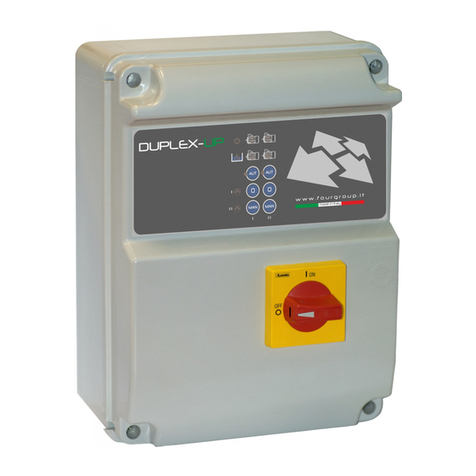
Fourgroup
Fourgroup DUPLEX-UP Use and installation guide
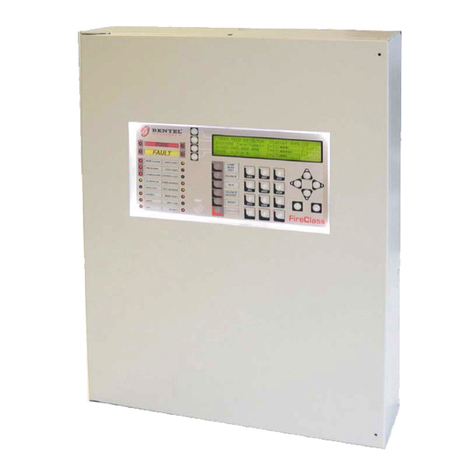
Bentel
Bentel FireClass FC500 user manual
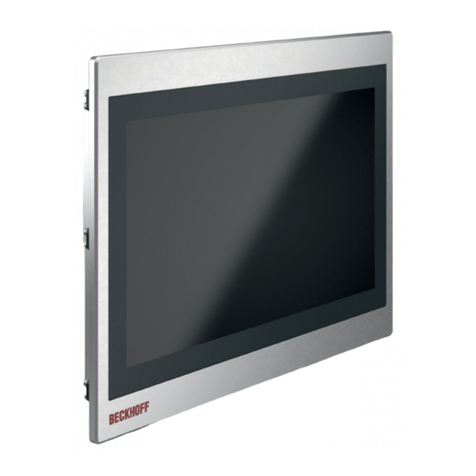
Beckhoff
Beckhoff CP29 -2 -0000 Series manual
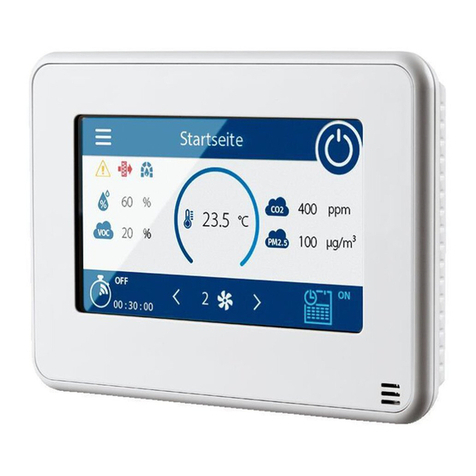
BLAUBERG Ventilatoren
BLAUBERG Ventilatoren S25 user manual
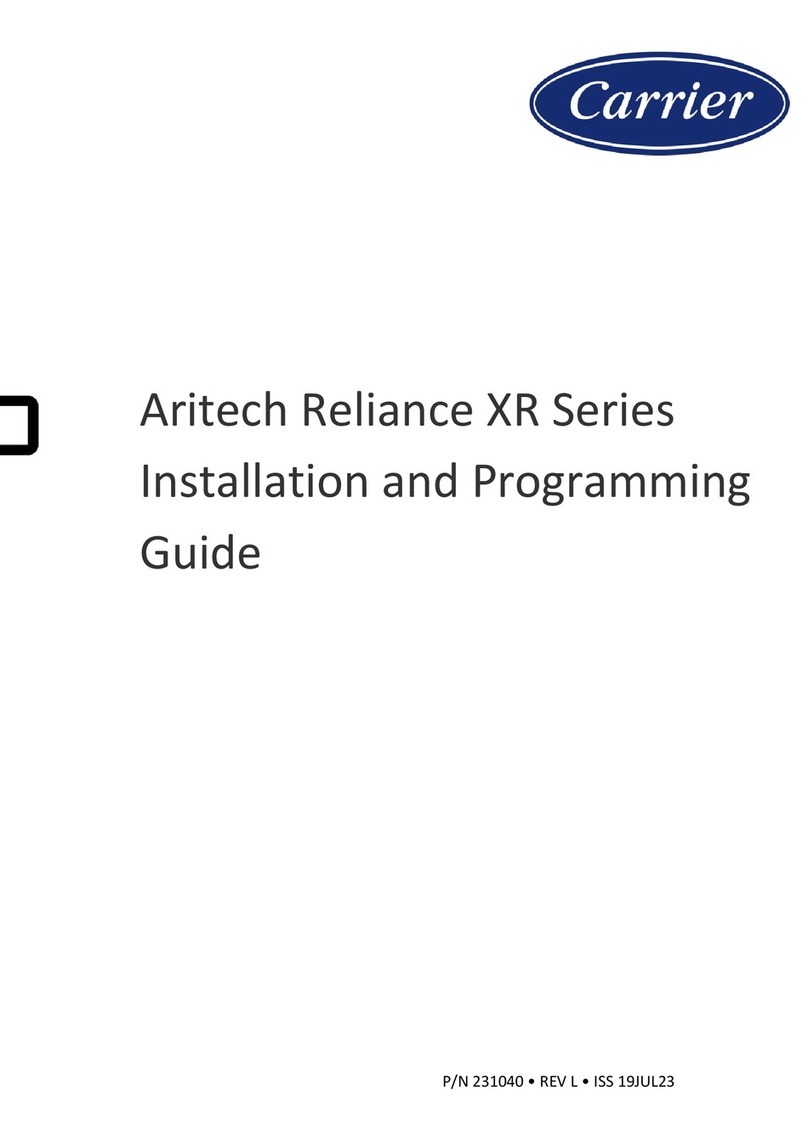
Carrier
Carrier Aritech Reliance XR Series Installation and programming guide
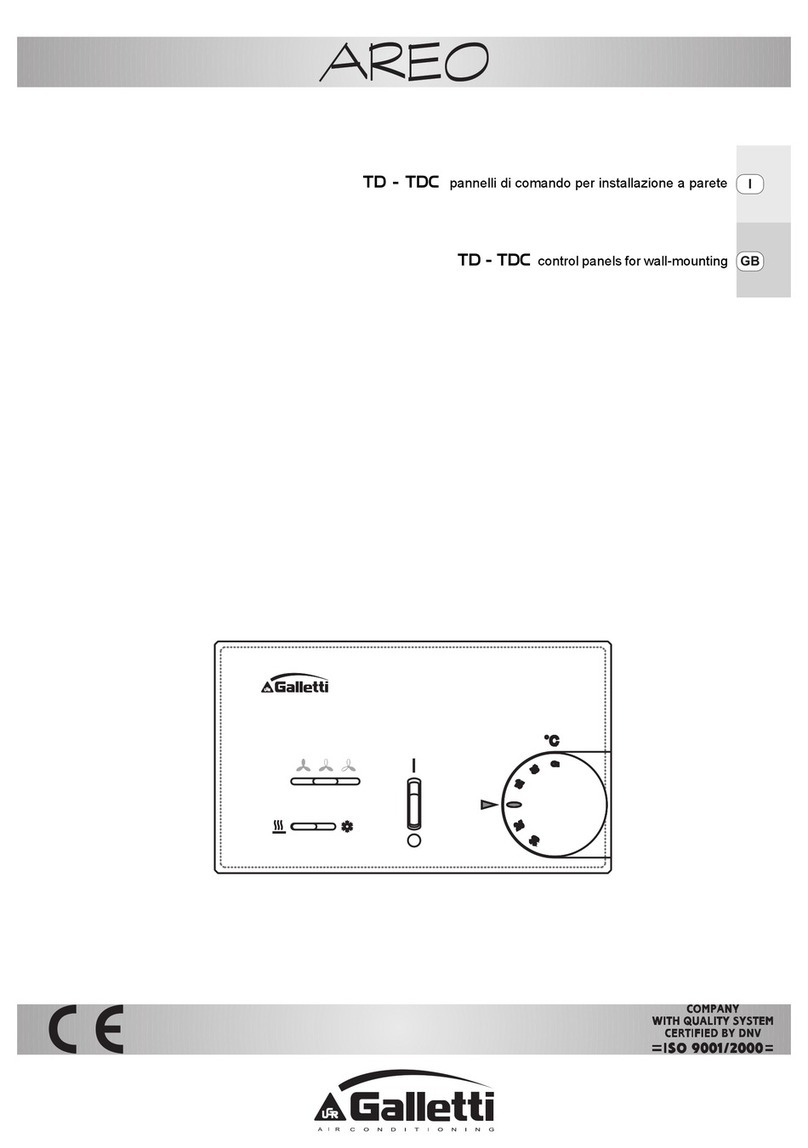
Galletti
Galletti AREO TD quick start guide


